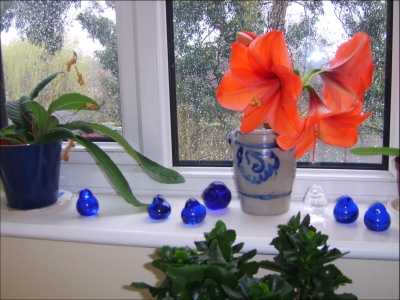Norwegian Nouns
Texts demonstrating nouns
Definite and Indefinite forms
Masculine nouns
En bil 'a car' becomes bilen 'the car'; en mann 'a man' becomes mannen 'the man'.
Examples: Bilen er ny. 'The car is new.'
Mannen er gammel. 'The man is old.'
Neuter nouns
Et hus 'a house' becomes huset 'the house'; et vindu 'a window' becomes vinduet 'the window'.
Examples: Huset er stort. 'The house is big.'
Vinduet er åpent. 'The window is open.'
Note:
- The definite article (the) goes at the end and that the t in huset etc. is not pronounced.
- Adjectives referring back to singular neuter nouns usually end in -t.
Feminine nouns
Most feminine nouns can also be used as masculine nouns, but not vice versa. For these words we use the term 'common gender'. You can say: ei dame 'a lady' - dama 'the lady', or: en dame - damen.
Feminine forms are used mainly in spoken colloquial Norwegian. In written Norwegian, (fiction - techinical - official language) the masculine form tends to be used more.
Which form you chose has to do with your style. The masciline (en) form is more conservative and literary. The feminine -a form is more colloquial and spoken.
Examples:
Dama satt på trappa og koste med katta. 'The lady sat on the steps cuddling the cat.' (coloquial/spoken)
Gata var lang og natta var mørk, den unge dama... 'The street was long and the night was dark...' (colloquial/spoken)
Damen satt på trappen og koste med katten. (conservative/literary)
Gaten var lang og natten var mørk, den unge damen... (conservative/literary)
However, there are common gender words that almost exclusively take the feminine form (ei in the singular Indefinite and -a in the singular Definite):
jente 'girl', kjerring 'old woman (derogatory)', hytte 'hut/cabin/summer house', bikkje 'dog', geit 'goat', ku 'cow', høne 'hen', gate 'street', bygd 'village/settlement', li 'hillside', myr 'bog', mark, meadow, øy 'island'
Plurals
The main rules are:
Indefinite plural
To form the Indefinite plural add -(e)r to masculine (-en words) and to feminine (-a words) and to neuter nouns:
Katter (cats), gutter (boys), jenter (girls), vinduer (windows)
Nouns ending in er only take -e in the Indefinite plural, e.g. en lærer - læreren - lærere.
(-et words, except monosyllables - see below) .
Jeg har to biler. 'I have two cars.' (masculine)
Han liker unge jenter. 'He likes young girls.' (feminine)
Jeg har to katter. 'I have two cats.' (common i.e. masculine and feminine)
Huset har fire vinduer. 'The house has four windows.' (neuter)
Definite plural 'e.g. bilene the cars'
Kattene (the cats), guttene (the boys), jentene (the girls), vinduene (the windows)
To form the Definite plural add -(e)ne to masculine (-en words), feminine (-a words) and neuter (-et words) Definite singulars.
Bilene står utenfor huset. 'The cars are (lit. 'standing') outside the house.' (masculine)
Jentene er ute og går. 'The girls are out walking.' (feminine)
Kattene sover. The cats are sleeping.' (common i.e. masculine and feminine)
Neuter nouns have a choice in the Definite plural between -ene and -a. As in common gender words the -a form is the more conservative and colloquial.
Husene er pene. 'The houses are nice.' (conservative/literary)
Husa er pene. 'The houses are nice.' (colloquial/spoken)
Jeg liker ikke folkene i klassen. 'I don't like the people in the class.'
Jeg liker ikke folka i klassen. 'I don't like the people in the class.'
A few nouns almost always take the -a form: barn 'child', bein / ben 'bone/leg', dyr 'animal', ku 'cow'
Barna er snille. 'The children are good.'
Jeg har vondt i beina. 'I have pain in the legs.' I.e. 'My legs hurt'.
Monosyllabic neuter nouns
Monosyllabic Indefinite neuter nouns e.g. hus have no ending in the plural, with a couple of exceptions.
Et bord - to bord 'a table - two tables'
Det er to bord i stua. 'There are two tables in the sitting room.'
Et dyr - to dyr 'an animal - two animals'
Jeg har mange dyr. 'I have many animals.'
Han har to hus. 'He has two houses (one syllable neuter word)
Han drakk to glass øl. 'He drank two glasses of beer.' (one syllable neuter word)
Neuter compound words where the last element is a monosyllabic neuter word follow the rule of monosyllabic neuter nouns e.g. et armbånd, arm+bånd (bracelet), et kjøleskap kjøle+skap (fridge/ literally cool cupboard, etc.
Et armbånd - to armbånd,
Et kjøleskap - to kjøleskap
A few masculine and feminine words follow the same rule: en ting - to ting, en sko - to sko, ei/ei mus - to mus
